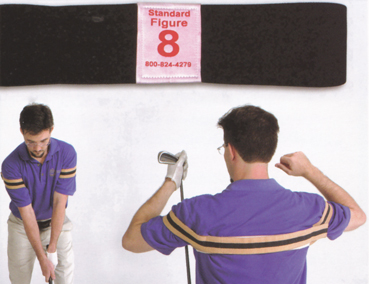What do all those gadgets do?
 My mom’s a great cook. Growing up I remember how I felt every time I pulled open the drawer in the kitchen where her cooking tools-of-
My mom’s a great cook. Growing up I remember how I felt every time I pulled open the drawer in the kitchen where her cooking tools-of-
the-trade were stored. I was subjected to this drawer each time I needed the can-opener. Or the veggie peeler, kept there tangled amid an assortment of rubber, wood and glinting steel. There was a sense of wonder surrounding this drawer, a world of intrigue and unknowns. It was, however, difficult not to shake my head, amused & think “What do all those gadgets do?”
The cover of this current Golf Teaching Pro magazine is intended to reflect the bewilderment felt by the average teaching pro when faced with the industry’s seemingly endless supply of game improvement aids. Just what do all these gadgets do?!? It adds to the confusion that most products, including Walter Hagen’s Strok-rite Strap (pictured here c. 1927), claim they will take strokes off your student’s scores and promise they “really work.” While writing this article I received the new John Daly POWERBeLT ™ claiming in bold letters to be The Most Effective Golf Swing Training Device – Ever! Different date, same story. But the truth is many of these products can be an invaluable asset to the golf teaching professional.
The first step towards knowing how and when to use a product is understanding how to classify the product. There is an important distinction to be made between teaching aids and training aids. A teaching aid (or learning aid) is used to help a student understand and perform some aspect of the golf swing. A training aid is used by the player to permanently engrain that feeling or swing motion. A product can be both a teaching and training aid. For example, the Impact Bag can be used to teach a player the flat left wrist, hands ahead, rotated hip position of impact, and through practice can train a player to develop a tangible feeling of ‘good impact’ that may be repeated time and time again. When working with students, keep the following rule of thumb in mind. Teaching aids = short term. Training aids = long term.
TEACHING = SHORT TERM TRAINING = LONG TERM
Consider the following scenario as an illustration of the importance of this principle. My student Molly has a swing flaw known as a ‘flying’ right elbow. The result of her position at the top of the backswing is an outside-in swingpath with a steep angle of approach to the ball. Common sense tells me to use a Figure 8 connection strap, a durable elastic band that will prevent her arms from separating. In the short term, I have ‘fixed’ Molly’s swing flaw. But when I take the Figure 8 strap off, it is a bigger struggle than ever to keep her right arm in check.
The key word in my example was prevent. My diagnosis of the problem was accurate, as was my impulse to provide a quick way to let Molly feel how I want her to swing. But the restriction and resistance of the strap may trigger an involuntary reaction to fight the change. If used long term, I would insist that the Figure 8 strap only be used on occasion to re-establish the feel of a connected swing.
A better long term alternative, for training, would be the Spine-a-Lin’r™. Like the Figure 8, the Spine-a-Lin’r slides up over the biceps, but attaches behind the player rather than in front of them (see picture). And again, Molly will instinctively pull against the strap as she swings. But unlike my experience when using the Figure 8 strap for an extended period, Molly is able to keep her right arm down without difficulty. I notice her posture is better, she stays connected; even her shoulder rotation is improved. The Spine-a-Lin’r has produced as positive change with a lasting result.
Back to the kitchen… A few years after my first encounter with my mom’s gadget filled drawer, I had to give a class speech; the topic:
medieval torture devices! I immediately headed for the kitchen drawer. While selecting the choices, a meat mallet, an apple corer, an ice pick, a pickle fork and a cheese grater, my mom taught me what many of the other “gadgets” did. She explained that the right tool at the right time makes all the difference.
No doubt, inventors of training aids will continue to be blinded to reason by their passion for perfecting the golf swing. It is likely that this contributes to the public’s perception that all golfers are a little crazy, as evidenced by Dr. Balata’s comments (inspired by actual patents!). In spite of this, a great many training aids are in fact very useful to the teacher of golf. Just remember the distinction between teaching aids and training aids and use the right tool at the right time.
After all, where would we be without the can opener?




